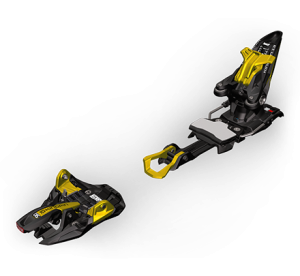Nontheless I did wrangle one detail out of an unsuspecting “insider” that the new binding would not latch in to the heel using the classic pair of spring bars on every other pintech binding, but hold down the heel like a regular alpine binding. This inevitably led to speculation that lateral release would come from the heel rotating ala a Tyrolia binding, which it does.
Last week the Kingpin was unveiled to select group of people in the ski industry. Apparently having a reputation as a free heeled telemarker has consequences.
Marker’s well produced video shows a lot of what is going on with the Kingpin.
Not having skied it yet there are only a few observations I can make. First, it looks like it addresses many of the excuses alpine skeptics have used to avoid switching to a 2-pin tech binding.
It has classic alpine heel hold down so your boot isn’t suspended between the two pins up front and two spring bars at the heel. Instead your boot is clamped at the heel, and perhaps even better than a typical alpine binding, since it is held down on the outer corners of the heel.
It looks like the same principles are at work here to reduce pre-release at the toe and make getting in to the binding easier with an approach similar to what G3 adopted with their Ion. Instead of changing the fulcrum point of the pin arms the Kingpin uses six springs on the toe piece to increase elasticity and thus retention force plus adjustable alignment posts for lining up toe inserts with the pins.
The most encouraging thing for alpine skeptics is the claim that the binding is TUV certified for reliable safety release. Marker emphasizes that with the Kingpin you don’t need to lock out release at the toes when skiing down to feel solid and secure while still having a safety release. Lest anyone forget, TUV certification of standard alpine bindings does not guarantee you’ll avoid injury, only that they release reliably in a strictly controlled situation (the test bench). Still, this is an important measure of accountability to resort bred alpine skiers.It looks like you might be able to switch to a free heel for touring without exiting the binding, but to do so will require more than just opening up the heel. You will also need to flip the Duke style mode lever back while your heel is lifted suggesting this will require some dexterity with a pole, and a fair amount of practice. Ninety percent of the time it doesn’t matter since switching to free heel mode means you’re going uphill and need to step out of the binding anyway to put climbing skins on. For the occasional shuffle across flats after a downhill pitch this would be a nice advantage.
The mounting pattern is 38mm wide, wider than older Dynafit bindings but on par with the new generation of pintech bindings. And yes, the two climbing posts deliver fairly standard heights of flat, 7° and 13°, and are easily engaged with a ski pole.
From a practical point of view the way the ski brakes can be swapped is nice, but more importantly, the fact that they retract inward so they don’t hang off the side is downright revolutionary. Having two widths spanning the range from 70-100mm or 100-125mm is nice. Crampons will also be available in three widths, 90, 105, and 120mm.
Weight is on the high side, but less than an Onyx or Beast. As has been pointed out repeatedly, a heavy pintech binding still tours great because you never lift the binding, only your boot. So a heavy 2-pin tech binding only increases drag weight, not inertial touring weight.
The big question, and one I don’t have an answer for, is when will they be available? My guess is not until 2015, but that means potentially this season. It also means alpine skiers are running out of excuses to avoid embracing the 2-pin tech system and there are a lot more details for new converts to consider when buying a tech binding besides weight and price. New criteria like ease of entry, and elasticity enter into the equation now, but the age old questions about releaseability can now be legitimately addressed, at least until field reports confirm or deny them.
With this announcement the year 2014 will go down in history as the year of the tech binding. Woe to those who are late to the plate, or merely churning out Dynafit knock-offs.
Marker
Kingpin
MSRP: $600 (5-10 DIN), $650 (6-13 DIN)
Weight/pr. (w/brakes): 3 lbs. 4 oz. (1480 g)
© 2014
Related Posts
Wildsnow take on the Kingpin
Backcountry Mag looks at developing Kingpin



4 comments
Skip to comment form
Hi Dotsie, one correction:
You said “This inevitably led to speculation that lateral release would come from the heel rotating ala a Tyrolia binding, which it does.”
Actually the lateral reléase is very diferent. Tyrolya don’t have a real lateral reléase, it does’t move until the vertical reléase is open. So yo hace to elevate the heel to move it laterally. So is not independent form vertical release. Kingpin laterla release is.
more, Tyrolia don’t have DIN regulation for the lateral “release”, Kingpin do
Pablo, Ya, thanks for the correction on Tyrolia’s lateral release at the heel. Indeed Marker’s Kingpin is an improvement, and distinctly different.
“From a practical point of view the way the ski brakes can be swapped is nice, but more importantly, the fact that they retract inward so they don’t hang off the side is downright revolutionary.” Is it really? I’m pretty sure my (now old) dynafits have always done this?
A lot of ski brakes retract inward. Duh! Not to the same degree though, although I’ll admit I’m taking Marker at their word on this since I haven’t actually skied or held these bindings yet. The pictures do indicate a degree of inward retraction that is definitely above average, and more than I’ve seen with any other binding.